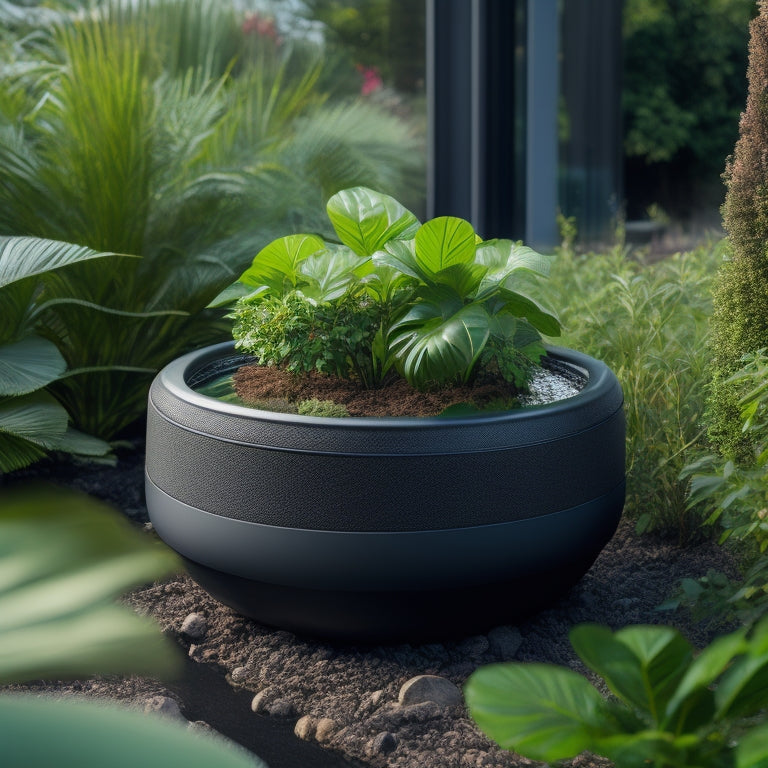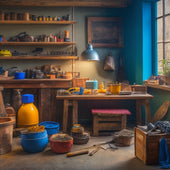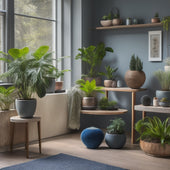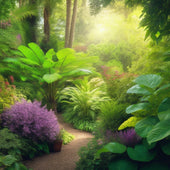
Build a Self-Watering Planter With DIY Ease
Share
You'll start by selecting the right materials, choosing food-grade plastic or PVC for the reservoir and weather-resistant materials like polypropylene or fiberglass for the planter body. Next, construct a structural base using cinder blocks, ensuring stability and drainage. Create a water reservoir with a drainage setup, layering small rocks, activated charcoal, and mesh to prevent clogging. Install an irrigation system with tubing and emitters for efficient water distribution. Then, prepare the soil and plants, and assemble the planter box with a waterproof liner. Finally, set up and maintain your self-watering planter, and you'll be ready to reap the benefits of automated watering and fertilization - but there's still more to explore to make your planter truly thrive.
Key Takeaways
• Choose food-grade plastic or PVC for the reservoir and weather-resistant materials like polypropylene or fiberglass for the planter body.
• Construct a stable base using cinder blocks with a 1-inch gap for drainage and a strategic pattern for weather resistance and weight support.
• Create a water reservoir with a drainage hole, layering small rocks, gravel, and activated charcoal for efficient water retention and distribution.
• Install an irrigation system with tubing, emitters, and a valve for capillary action, excess water drainage, and efficient water distribution.
• Select a well-draining potting mix, plant compatible greenery, and maintain the planter by monitoring moisture levels, pruning, and fertilizing regularly.
Choosing the Right Materials
What makes a self-watering planter truly effective is the selection of materials that guarantee efficient water distribution and aeration.
You'll want to choose materials that are durable, resistant to decay, and able to withstand exposure to water and sunlight. For the planter's reservoir, consider using a food-grade plastic or PVC material that won't contaminate the water or leach harmful chemicals into the soil. The material should also be UV-stable to prevent degradation over time.
For the planter's body, you can opt for a durable, weather-resistant material like polypropylene or fiberglass. These materials are resistant to cracks and fading, making certain your planter remains functional and visually appealing for years to come.
When selecting materials, consider factors like moisture absorption, thermal expansion, and resistance to extreme temperatures. You'll also want to make sure the materials are easy to clean and maintain to prevent the buildup of bacteria and algae.
Building the Cinder Block Base
When building the cinder block base, you'll need to select blocks that meet specific criteria, considering factors like weight capacity, drainage, and durability.
You'll also need to develop a strategic plan for placing the blocks to guarantee stability and even weight distribution.
Block Selection Criteria
You'll need to select cinder blocks that meet specific criteria to fulfill a sturdy base for your self-watering planter. When choosing blocks, consider both durability and aesthetics to guarantee your planter looks great and lasts long. Here are some key factors to evaluate:
| Criteria | Description | Why It Matters |
|---|---|---|
| Block Type | Solid, hollow, or split-face blocks | Affects weight, drainage, and structural integrity |
| Material Strength | Compression strength, measured in pounds per square inch (psi) | Impacts resistance to weathering and weight capacity |
| Color and Texture | Variety of colors, smooth or rough textures | Influences visual appeal and blending with surroundings |
Block durability considerations include selecting blocks with high compression strength to support the weight of the planter and its contents. Aesthetic block options range from solid, hollow, or split-face blocks in various colors and textures. By considering these factors, you can create a sturdy and visually appealing base for your self-watering planter.
Block Placement Strategy
With your chosen blocks meeting the necessary criteria, start building the cinder block base by laying the first course, guaranteeing a level foundation for your self-watering planter. Use a spirit level to confirm the blocks are perfectly horizontal.
Begin by placing the first block at the center of your planter's base, then work your way outward in a staggered pattern. This block arrangement will provide additional strength and stability to your structure.
When laying each subsequent course, verify the blocks are aligned with the ones below, maintaining a consistent pattern. Make certain to leave a 1-inch gap between each block for drainage considerations, allowing excess water to escape and preventing waterlogged soil.
As you build, check the level frequently to avoid any deviations. It's essential to maintain a level base to prevent your planter from leaning or toppling over.
Creating the Water Reservoir
Drill a hole in the bottom of the container, about 1 inch from the bottom, to create an outlet for the water reservoir. This outlet will allow excess water to drain, ensuring your planter doesn't become waterlogged.
Next, cut a piece of mesh or landscape fabric to fit inside the container, covering the hole you just drilled. This will prevent soil from entering the water reservoir and clogging the drainage system.
Now, fill the container with a layer of small rocks or gravel, about 2-3 inches deep. This layer will facilitate water retention and provide a stable base for your soil.
On top of the rocks, add a layer of activated charcoal or a similar drainage solution to help regulate moisture levels and prevent waterlogged soil.
Adding the Irrigation System
Next, create a simple irrigation system by cutting a length of tubing or hose to fit inside the container, guaranteeing one end reaches the water reservoir and the other end terminates near the soil surface. This will allow you to harness the power of capillary action, a key irrigation technique that promotes water conservation.
As the soil dries, it will draw water up from the reservoir, reducing the need for frequent watering. You can further optimize this system by adding a small hole or valve near the soil surface, allowing excess water to drain back into the reservoir.
To guarantee efficient water distribution, you can add a few small holes or emitters along the length of the tubing, spaced evenly apart. This will provide a steady supply of water to the roots of your plants, while minimizing evaporation and runoff.
Planting and Soil Preparation
Now that your irrigation system is in place, you'll want to prepare the soil and plant your chosen variety. Carefully select a potting mix specifically designed for containers to guarantee ideal drainage and aeration. This is essential, as poor drainage can lead to waterlogged soil and root rot.
When selecting a potting mix, look for one that's labeled as 'well-draining' or 'container-specific.' Avoid using soil from your garden, as it can compact and prevent proper drainage.
For plant selection, consider the specific needs of your chosen variety. Some plants thrive in acidic soil, while others prefer alkaline conditions. Make sure to choose a plant that's compatible with the soil type you've selected. If you're unsure, consult with a gardening expert or do further research.
When preparing the soil, gently loosen the potting mix to prevent compaction. Add any necessary fertilizers or amendments according to the manufacturer's instructions. Plant your chosen variety at the recommended depth, and gently firm the soil around the roots to secure them in place.
With the right soil and plant selection, you'll be well on your way to a thriving self-watering planter.
Assembling the Planter Box
With your soil and plant selection in order, you can proceed to assemble the planter box, starting with the inner reservoir and water-wicking system that will supply your plants with the right amount of moisture.
Begin by attaching the waterproof liner to the inside of the planter box, ensuring a snug fit to prevent any leaks. Next, cut the water-wicking material to the correct size, allowing it to dangle about 2-3 inches below the planter's bottom. This will enable the plants to draw water as needed.
Assemble the planter box according to your planter dimensions, ensuring the inner reservoir is securely fitted. Pay attention to planter aesthetics, as the design should complement your outdoor space.
Use screws or nails to secure the slats, making sure the corners are sturdy. Add the water inlet and outlet tubes, connecting them to the inner reservoir. Finally, add the decorative exterior, such as wood trim or paint, to complete the planter's look.
With the planter box assembled, you're one step closer to creating a self-watering system that gives you control over your plants' hydration.
Finishing Touches and Maintenance
You can add the finishing touches to your DIY self-watering planter by filling the inner reservoir with water, then carefully planting your selected greenery in the soil, making sure not to compact the soil too much. This will guarantee your plants receive the right amount of moisture and nutrients.
To maintain your planter, follow these seasonal adjustments and troubleshooting tips:
| Seasonal Adjustments | Troubleshooting Tips |
|---|---|
| Check water levels daily during hot summer months | Check for clogged pipes or tubes |
| Reduce water levels during cool winter months | Inspect soil moisture and adjust as needed |
| Prune plants regularly to promote healthy growth | Monitor for signs of overwatering or underwatering |
| Fertilize plants during growing seasons | Check for pests or diseases and treat promptly |
| Repot plants every 1-2 years for ideal growth | Regularly inspect the planter's overall condition |
Frequently Asked Questions
Can I Use a Different Type of Block Instead of Cinder Blocks?
You're wondering if you can swap out cinder blocks for something else.
Absolutely, you can! Alternative materials like concrete blocks, bricks, or even recycled plastic blocks can work just as well.
Just guarantee they provide adequate drainage solutions, such as holes or channels, to prevent waterlogged soil.
Remember to assess the material's weight, durability, and moisture resistance before making your selection.
How Often Should I Refill the Water Reservoir in the Planter?
Like the ancient Egyptians monitoring the Nile's floods, you'll need to keep a close eye on your planter's water level.
Refill frequency depends on factors like soil type, climate, and plant species.
Check the water level weekly, and top it off when it drops by about an inch.
In hot or dry conditions, you might need to refill every 3-4 days.
Keep an eye on your plants' response and adjust your refill schedule accordingly.
Will the Self-Watering System Work for All Types of Plants?
You're wondering if the self-watering system will work for all types of plants.
The truth is, it depends on the plant types and their unique watering needs. Some plants, like succulents, prefer infrequent watering, while others, like ferns, need constant moisture.
You'll need to research the specific requirements of your plants and adjust the system accordingly.
Can I Make the Planter Box Smaller or Larger in Size?
Imagine a tailored planter, perfectly suited to your space.
You can scale the planter box to fit your needs, adjusting the dimensions to accommodate the space you have available.
Consider the mature size of your plants and the space constraints of your balcony, patio, or indoor area.
How Do I Prevent Mosquitoes From Breeding in the Water Reservoir?
To prevent mosquitoes from breeding in the water reservoir, you'll want to focus on mosquito prevention and regular water maintenance.
First, guarantee the water level is below the soil surface to prevent mosquito eggs from hatching.
Next, add a few drops of mosquito-killing agents, like pyrethrin or neem oil, to the water.
Regularly check and replace the water every 7-10 days to disrupt the mosquito breeding cycle.
Conclusion
You've successfully built a self-watering planter that'll make your green thumb proud!
As the old adage goes, 'Give a man a fish and you feed him for a day; teach a man to fish and you feed him for a lifetime.'
With this DIY project, you've learned to create a sustainable and efficient way to care for your plants.
Now, sit back, relax, and enjoy the fruits of your labor as your plants thrive with minimal maintenance.
Related Posts
-

3 Best Tool Essentials for Creative Concrete Planters
To create visually stunning and durable concrete planters, you'll need three essential tool categories. First, you'll...
-

3 Best Tool Essentials for Creative Concrete Planters
To create visually stunning and durable concrete planters, you'll need three essential tool categories. First, you'll...
-

3 Best Tool Essentials for Creative Concrete Planters
To create visually stunning and durable concrete planters, you'll need three essential tool categories. First, you'll...
-

3 Best Tool Essentials for Creative Concrete Planters
To create visually stunning and durable concrete planters, you'll need three essential tool categories. First, you'll...
-

3 Best Tool Essentials for Creative Concrete Planters
To create visually stunning and durable concrete planters, you'll need three essential tool categories. First, you'll...
-

3 Best Tool Essentials for Creative Concrete Planters
To create visually stunning and durable concrete planters, you'll need three essential tool categories. First, you'll...
-

3 Best Tool Essentials for Creative Concrete Planters
To create visually stunning and durable concrete planters, you'll need three essential tool categories. First, you'll...
-

3 Best Tool Essentials for Creative Concrete Planters
To create visually stunning and durable concrete planters, you'll need three essential tool categories. First, you'll...
-

3 Best Tool Essentials for Creative Concrete Planters
To create visually stunning and durable concrete planters, you'll need three essential tool categories. First, you'll...
-

3 Best Tool Essentials for Creative Concrete Planters
To create visually stunning and durable concrete planters, you'll need three essential tool categories. First, you'll...
-

3 Best Tool Essentials for Creative Concrete Planters
To create visually stunning and durable concrete planters, you'll need three essential tool categories. First, you'll...
-

3 Best Tool Essentials for Creative Concrete Planters
To create visually stunning and durable concrete planters, you'll need three essential tool categories. First, you'll...
-

3 Best Tool Essentials for Creative Concrete Planters
To create visually stunning and durable concrete planters, you'll need three essential tool categories. First, you'll...
-

3 Best Tool Essentials for Creative Concrete Planters
To create visually stunning and durable concrete planters, you'll need three essential tool categories. First, you'll...
-

7 Best Concrete Planter Ideas for Indoor Gardens
You're looking for a stylish and low-maintenance way to bring some greenery into your home, and concrete planters off...
-

7 Best Concrete Planter Ideas for Indoor Gardens
You're looking for a stylish and low-maintenance way to bring some greenery into your home, and concrete planters off...
-

7 Best Concrete Planter Ideas for Indoor Gardens
You're looking for a stylish and low-maintenance way to bring some greenery into your home, and concrete planters off...
-

7 Best Concrete Planter Ideas for Indoor Gardens
You're looking for a stylish and low-maintenance way to bring some greenery into your home, and concrete planters off...
-

7 Best Concrete Planter Ideas for Indoor Gardens
You're looking for a stylish and low-maintenance way to bring some greenery into your home, and concrete planters off...
-

7 Best Concrete Planter Ideas for Indoor Gardens
You're looking for a stylish and low-maintenance way to bring some greenery into your home, and concrete planters off...
-

7 Best Concrete Planter Ideas for Indoor Gardens
You're looking for a stylish and low-maintenance way to bring some greenery into your home, and concrete planters off...
-

7 Best Concrete Planter Ideas for Indoor Gardens
You're looking for a stylish and low-maintenance way to bring some greenery into your home, and concrete planters off...
-

7 Best Concrete Planter Ideas for Indoor Gardens
You're looking for a stylish and low-maintenance way to bring some greenery into your home, and concrete planters off...
-

7 Best Concrete Planter Ideas for Indoor Gardens
You're looking for a stylish and low-maintenance way to bring some greenery into your home, and concrete planters off...
-

7 Best Concrete Planter Ideas for Indoor Gardens
You're looking for a stylish and low-maintenance way to bring some greenery into your home, and concrete planters off...
-

7 Best Concrete Planter Ideas for Indoor Gardens
You're looking for a stylish and low-maintenance way to bring some greenery into your home, and concrete planters off...
-

7 Best Concrete Planter Ideas for Indoor Gardens
You're looking for a stylish and low-maintenance way to bring some greenery into your home, and concrete planters off...
-

7 Best Concrete Planter Ideas for Indoor Gardens
You're looking for a stylish and low-maintenance way to bring some greenery into your home, and concrete planters off...
-

7 Best Concrete Planter Ideas for Indoor Gardens
You're looking for a stylish and low-maintenance way to bring some greenery into your home, and concrete planters off...
-

7 Best Concrete Planter Ideas for Indoor Gardens
You're looking for a stylish and low-maintenance way to bring some greenery into your home, and concrete planters off...
-

7 Best Concrete Planter Ideas for Indoor Gardens
You're looking for a stylish and low-maintenance way to bring some greenery into your home, and concrete planters off...
-

7 Best Concrete Planter Ideas for Indoor Gardens
You're looking for a stylish and low-maintenance way to bring some greenery into your home, and concrete planters off...
-

7 Best Concrete Planter Ideas for Indoor Gardens
You're looking for a stylish and low-maintenance way to bring some greenery into your home, and concrete planters off...
-

7 Best Concrete Planter Ideas for Indoor Gardens
You're looking for a stylish and low-maintenance way to bring some greenery into your home, and concrete planters off...
-

7 Best Concrete Planter Ideas for Indoor Gardens
You're looking for a stylish and low-maintenance way to bring some greenery into your home, and concrete planters off...
-

7 Best Concrete Planter Ideas for Indoor Gardens
You're looking for a stylish and low-maintenance way to bring some greenery into your home, and concrete planters off...
-

7 Best Concrete Planter Ideas for Indoor Gardens
You're looking for a stylish and low-maintenance way to bring some greenery into your home, and concrete planters off...
-

5 Tips for Shaded Area Gardening Success
To turn your shaded areas into thriving gardens, start by selecting shade-tolerant crops like leafy greens and herbs,...
-

5 Tips for Shaded Area Gardening Success
To turn your shaded areas into thriving gardens, start by selecting shade-tolerant crops like leafy greens and herbs,...
-

5 Tips for Shaded Area Gardening Success
To turn your shaded areas into thriving gardens, start by selecting shade-tolerant crops like leafy greens and herbs,...
-

5 Tips for Shaded Area Gardening Success
To turn your shaded areas into thriving gardens, start by selecting shade-tolerant crops like leafy greens and herbs,...
-

5 Tips for Shaded Area Gardening Success
To turn your shaded areas into thriving gardens, start by selecting shade-tolerant crops like leafy greens and herbs,...
-

5 Tips for Shaded Area Gardening Success
To turn your shaded areas into thriving gardens, start by selecting shade-tolerant crops like leafy greens and herbs,...
-

5 Tips for Shaded Area Gardening Success
To turn your shaded areas into thriving gardens, start by selecting shade-tolerant crops like leafy greens and herbs,...
-

5 Tips for Shaded Area Gardening Success
To turn your shaded areas into thriving gardens, start by selecting shade-tolerant crops like leafy greens and herbs,...
-

5 Tips for Shaded Area Gardening Success
To turn your shaded areas into thriving gardens, start by selecting shade-tolerant crops like leafy greens and herbs,...
-

5 Tips for Shaded Area Gardening Success
To turn your shaded areas into thriving gardens, start by selecting shade-tolerant crops like leafy greens and herbs,...
-

5 Tips for Shaded Area Gardening Success
To turn your shaded areas into thriving gardens, start by selecting shade-tolerant crops like leafy greens and herbs,...
-

5 Tips for Shaded Area Gardening Success
To turn your shaded areas into thriving gardens, start by selecting shade-tolerant crops like leafy greens and herbs,...
-

5 Tips for Shaded Area Gardening Success
To turn your shaded areas into thriving gardens, start by selecting shade-tolerant crops like leafy greens and herbs,...
-

5 Tips for Shaded Area Gardening Success
To turn your shaded areas into thriving gardens, start by selecting shade-tolerant crops like leafy greens and herbs,...
-

5 Tips for Shaded Area Gardening Success
To turn your shaded areas into thriving gardens, start by selecting shade-tolerant crops like leafy greens and herbs,...
-

5 Tips for Shaded Area Gardening Success
To turn your shaded areas into thriving gardens, start by selecting shade-tolerant crops like leafy greens and herbs,...
-

5 Tips for Shaded Area Gardening Success
To turn your shaded areas into thriving gardens, start by selecting shade-tolerant crops like leafy greens and herbs,...
-

5 Tips for Shaded Area Gardening Success
To turn your shaded areas into thriving gardens, start by selecting shade-tolerant crops like leafy greens and herbs,...
-

5 Tips for Shaded Area Gardening Success
To turn your shaded areas into thriving gardens, start by selecting shade-tolerant crops like leafy greens and herbs,...
-

5 Tips for Shaded Area Gardening Success
To turn your shaded areas into thriving gardens, start by selecting shade-tolerant crops like leafy greens and herbs,...


